Gowns
The style of gowns, or dresses, changed with each age. Please note that all the gowns following are from medieval Europe.
Redwall gowns are usually nonexistent except in the case of the royal family of Southsward. I believe Celandine of the Rambling Rosehip Players also wore a gown much of the time. Female creatures in the Redwall series, when they want to dress up, typically wear simple dresses.
![]()
During the Reign of William the Conqueror
1066-1087
Gowns during this age were extremely plain and simple. A gown was typically very loose, reaching to the knees, worn over a long chemise, and gathered at the waist by a belt made of wool, cloth, silk, or cloth of gold web. It was close-fitting at the shoulders but the sleeves below that were loose, and widened as they went, ending just below the elbows. The collar was a v-neck about five inches long, and often the gown, collar, and sleeves were edged with fine embroidery. The chemise was a plain white dress with long, tight sleeves. A long cloak was often worn over all of this, as well as a cloth wimple much like a mantle.
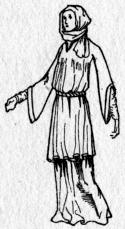
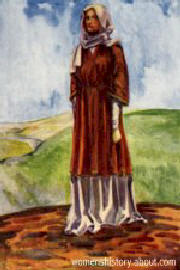
![]()
During the Reign of William the Second
1087-1100
Rather than the loose-fitting gowns of 1066-1087, women now began to wear corsets, lacing their clothing up in the back. Lacing was not extremely tight, though- it did more to make the front of the dress appear smooth rather than to thin the waist. Gowns fit close to the torso, though skirts were still loose, long, and full. Sleeves were semi-tight until they reached from the elbow to the wrist, at which point they were suddenly very long. Cloaks were now held tightly over the shoulder by laces or bands which were fastened at the brooch and ran around the back. A mantle-like wimple was still worn, and some people still wore the gowns from the age of William the Conquerer.
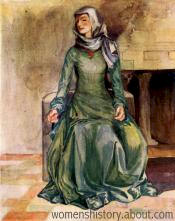
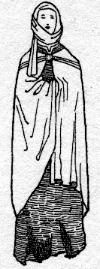
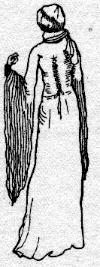
![]()
During the Reign of Henry I
1100-1135
Gowns didn't change much from the reign of William the Second to the reign of Henry the First. The wimple was discarded, and hair typically hung down in two long braids. Loose gowns were preferred over the laced ones, and were tied by a long girdle, which often had knots or tassels at its ends. Sleeves were somewhat different- rather than the loosely long sleeves of the previous age, they were now cut almost triangularly, as seen in the drawing below. A loose silk coat called the pelisse was often worn over the gown, fastened at the waist by a brooch or a button. The pelisse was copied from that worn by Persian ladies.
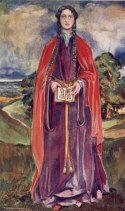
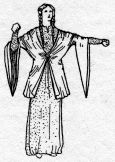
![]()
During the Reign of Stephen of England
1135-1154
An undergarment called a camise was worn at this time. It was similar to the chemise- long, white, with tight sleeves, and simply made. It sometimes had some light embroidery on it. There were three main types of overgarments.
One was made of several different materials- from the neck to almost to the waist, including the sleeves, it was made of a soft material. From the first material to the hips it was made of a tight-fitting, elastic material that was laced at the back. From the hips down, the same soft material as the first section was used.
Another was close-fitting from neck to hips and made of an elastic material such as knitted wool or thin cloth, and the skirt was made of a very thin material, almost a gauze.
The third type was a loose tunic that ended somewhere below the knees and above the ankles, tied about the waist by a loose girdle.
The sleeves varied, but the poor wore tighter-fitting sleeves that wouldn't get in the way of work, while those more wealthy wore longer sleeves as in the previous ages. Longer sleeves were often knotted. The sleeves and collar were typically embroidered with a simple, bold design. In winter, a semi-circular, embroidered cloak was also worn.
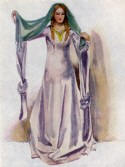
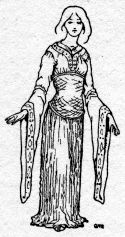
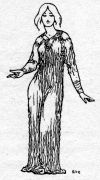
![]()
During the Reign of Henry II
1154-1189
The gown in this age was somewhat loose-fitting, and had a deep band around the neck and the hem of the very full skirts. A girdle was tied around the waist, and was usually somewhat ornamental. A chemise was worn beneath the gown, and had a high neck that showed above the gown's neck. The sleeves were somewhat close-fitting until they reached the elbow, at which point they became loose and widened over the wrist. The sleeves were bordered with heavy embroidery. On some occasions they would be edged with fur, and the hem may have been bordered with fur as well. The girdle was sometimes accompanied by a broad, buckled silk or leather belt with a very long tongue that reached to the knee and sometimes below. The gown was covered by a light cloak made of silk or fine cloth that was secured to the shoulders by a band or a silken cord.
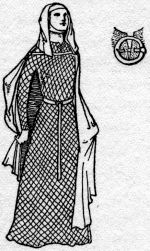
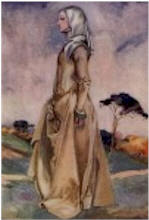
![]()
During the Reign of Richard I
1189-1199
In this time, much of foreign styles were borrowed to give women's clothing an exotic flair. Some of Paris and the Orient was added to the Norman dress. Gowns were long, simply designed, and loose, with fine colors. Belts were decorated with buckles, brooches, and ornamental studs. Cloaks were long and held around the shoulders with only a simple cord. Belts were leather or silk with a knee-length tongue, and were buckled about the waist fairly loosely. The sleeves were very loose and came tight only at the wrist.
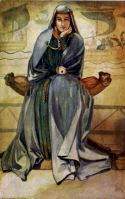
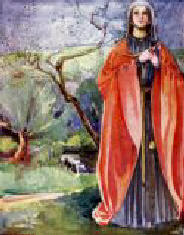
![]()
During the Reign of Henry III
1216-1272
Gowns were loose, flowing, and simple, tied at the waist by a girdle. The sleeves were either close-fitting and full-length, or loose-fitting and cut just below the elbow. Often the second type of gown mentioned was worn overtop the first.
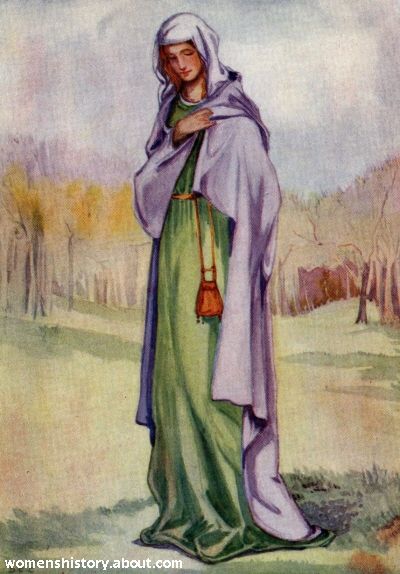
![]()
For More Information: